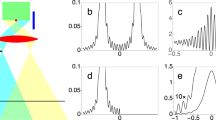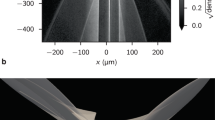Abstract
IN the Sitzungsberichte of the Berlin Academy of December 8 last, which has recently come to hand, Einstein describes an ingenious arrangement which he suggests might serve to decide between the classical theory of light and the theory in which light is regarded as made up of single quanta of energy emitted discontinuously from luminous atoms. Fig. 1 (reproduced from the paper) illustrates the proposed experiment. K is a stream of canal rays, L1 is a focussing lens, S is a screen containing a slit which serves to isolate a definite pencil of light, and the lens L2 renders the emergent beam parallel. The emergent pencil is observed through a telescope focussed for infinity, so that the image of the slit in the screen S would be seen sharply focussed in the field of view. Since the atoms in the canal rays emitting light are in motion, the Doppler effect comes into evidence, and the rays proceeding at any instant from individual luminous atoms in different directions should, according to the wave-theory of light, be of different frequencies. Einstein suggests that the rays passing through the slit S and incident on the upper and lower parts of the lens L2 should consequently be of different frequencies. If, therefore, a layer of a dispersing medium such as carbon disulphide be placed between the lens L2 and the observing telescope, the different rays would travel through it with different velocities. Hence the wave-front should suffer an aberration and the image of the slit seen in the focal plane should shift through an extent proportionate to the thickness of the dispersing layer introduced. Einstein conceives that according to the quantum theory of light, on the other hand, such displacement should not occur, and he believes that the proposed arrangement furnishes an experimentum crucis to decide between the rival theories.
This is a preview of subscription content, access via your institution
Access options
Subscribe to this journal
Receive 51 print issues and online access
$199.00 per year
only $3.90 per issue
Buy this article
- Purchase on Springer Link
- Instant access to full article PDF
Prices may be subject to local taxes which are calculated during checkout
Similar content being viewed by others
Author information
Authors and Affiliations
Rights and permissions
About this article
Cite this article
RAMAN, C. Einstein's Aberration Experiment. Nature 109, 477–478 (1922). https://doi.org/10.1038/109477b0
Issue Date:
DOI: https://doi.org/10.1038/109477b0
Comments
By submitting a comment you agree to abide by our Terms and Community Guidelines. If you find something abusive or that does not comply with our terms or guidelines please flag it as inappropriate.



